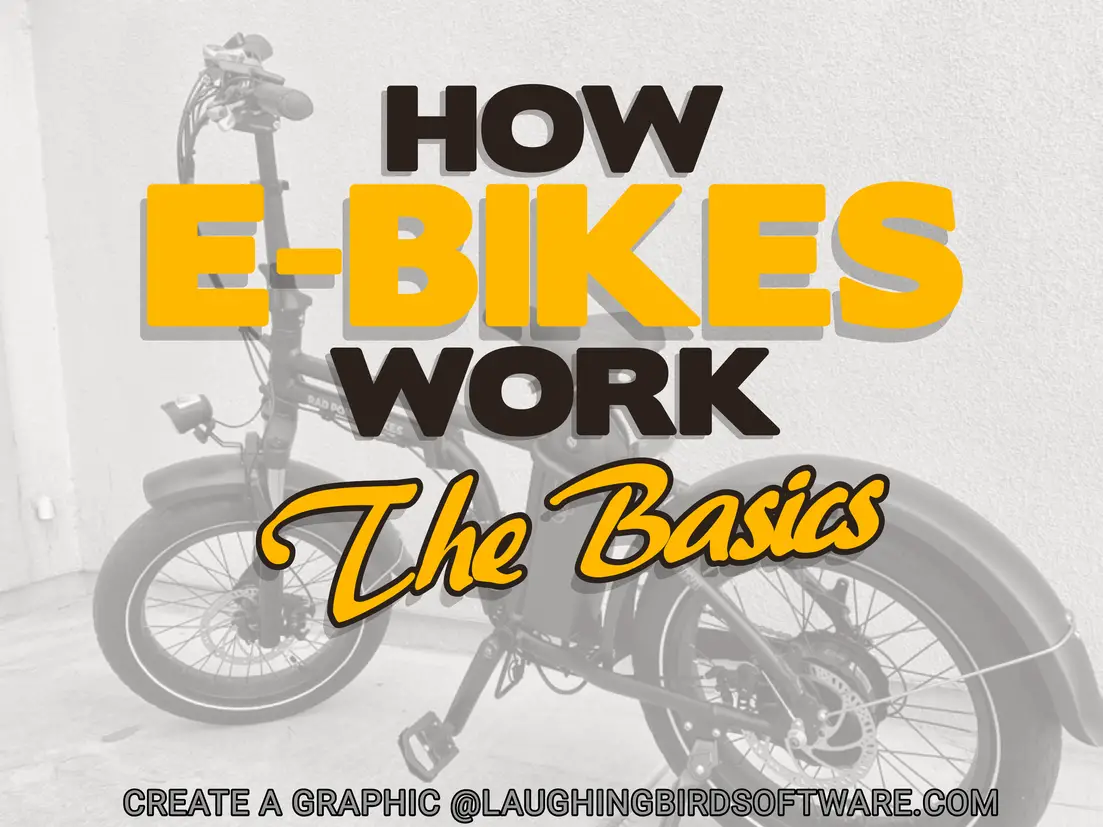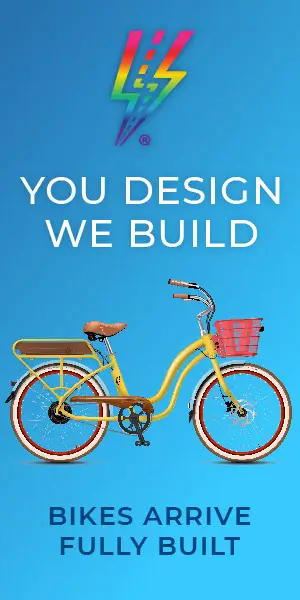E-bikes are incredible inventions that started becoming popular in the 1990s. They are a complex combination of both mechanical and electrical engineering. Although you don’t need to know every single aspect of how an e-bike works, it’s a good idea to understand some of the basic principles behind the e-bike if you own one or are thinking of buying one.
An electric bike works much like a regular bicycle. However, e-bikes have electrical components, a motor, and a battery, that assist the rider in moving forward. The electric power helps a rider manage hills and wind as well as to ride longer and farther (without getting over-tired).
This article will go into detail about how an e-bike functions as both a mechanical vehicle, as well as an electric motorized machine.
The Basics of How an Electric Bike Works
An electric bike uses electrical energy to move the bike forward, either entirely on its own or with the assistance of the rider. An e-bike will have the same structure as a normal bike but will also have a battery and a motor.
I’ll explain the details of each component of the electric bike in more detail below, but here are some of the basics.
An e-bike is first and foremost a bicycle
Because an e-bike also operates as a normal bike, here are the basics of how your e-bike moves.
As you pedal, the rotational motion turns a set of gears, known as the cranks, which are attached to a chain. The chain is also attached to a set of gears in the middle of the rear wheel.
As the cranks turn and move the chain, the chain will rotate the gears on the rear wheel. Because these gears are attached to the rear wheel, the wheel will also begin to rotate, propelling the bike forwards.
How does the motor help an electric bike move?
Electric bikes can move in one of three ways.
- Pedaling with no power assistance
- Pedaling with power assistance
- Using the throttle instead of pedaling
You can choose to ride your electric bike without the battery or motor, using it as a normal bike as I explained above. This works either by not turning on the battery at all or by setting the pedal assist gears to the “off” or level “0” power assistance.
This isn’t recommended on any amount of an incline because electric bikes are naturally much heavier than regular bikes, making them harder to ride. But you might want to do this if you’re going downhill or riding on a fairly level surface, either to get more exercise or to conserve your battery. Further, having this option allows you to still get home if you run out of battery, as you can pedal it like a normal bike.
The most common way an e-bike will move is by pedaling with the power turned on. With most motors, the act of pedaling engages the power in the motor, so you don’t have to actively turn on the power assistance. This motor contributes to either the rotation of the chain or the wheel to make riding the bike easier.
Usually, you can cycle through multiple settings that alter how much assistance the motor provides. Some people prefer to use minimal assistance to spare their battery and increase their workout. Others prefer to use maximum assistance to make the ride easier and more enjoyable.
The final way of moving the electric bike is with a throttle. This means you don’t have to pedal the bike, you just have to twist the throttle on the handlebar to make the bike move forward. The motor, again, either moves the chain or rotates the tire, but this time without any help from you.
The more you twist the throttle, the faster the electric bike will go. It’s similar to a motorbike but won’t go nearly as fast. However, it’s not common to have an e-bike that only has a throttle function. More commonly e-bikes will have both a throttle and pedal-assist motor, or they’ll just be pedal assisted.
So do you have to pedal to make it work?
If you have an electric bike that has a throttle, you can choose not to pedal the bike at all. However, this does drain your battery very quickly. If you have a pedal-assisted e-bike, also known as a ‘pedelec’, you must pedal for the motor to be engaged.
Find out more about how to use a throttle and pedal assist here:
Does the e-bike charge itself?
Technology exists for an e-bike to charge itself while you ride, but this is not a very popular or common feature. The main way the bike can recharge its battery is by using ‘regenerative’ braking. A sensor will detect when you are using the brakes, trigger the motor into a reverse mode, and then use the excess energy to charge the battery.
Unfortunately, this technology would make the battery component of the bike significantly heavier and only 5-10% of the energy lost while braking can be fed back into the battery.
This means you would get 1 extra mile out of your battery on a 10-mile trip. Because of the extra weight of the recharging components, this small recharge is generally not worth it. Therefore, most e-bikes don’t have this feature.
I go into depth about e-bike batteries and their charge further on in this article.
Do you need to change gears on an electric bike?
Some e-bikes don’t come with gears and these are known as single-speed electric bikes. In saying that, most e-bikes do have gears included. Most commonly, e-bikes will have 5-8 gears to cycle through as you pedal.
So if you have a single-speed electric bike, you won’t have to change any gears. If you have an e-bike that does have gears, you’ll want to change them as you ride, starting in the lowest gear (which is paradoxically, the highest-numbered gear).
You’ll want to shift gears because riding in a consistent low gear will make your motor work harder and drain your battery. And riding in high gear (the lower-numbered gears) will make it much easier to pedal.
Most people prefer to have gears on their electric bikes so they have more control over how much effort they put into the ride. This also allows them to control how much battery is used and makes it easier to ride if they run out of battery.
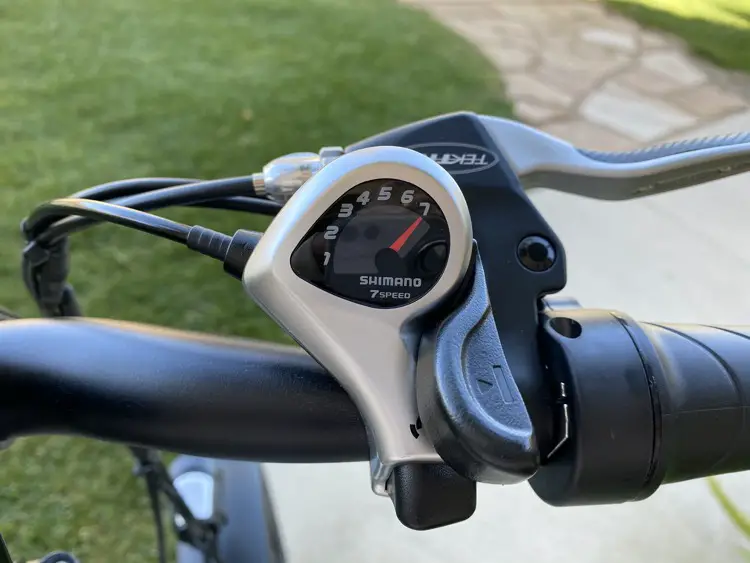
How do I change gears on an e-bike?
In terms of changing gears, think of an electric bike as a normal bike. Start pedaling in the lowest gear and change gears in increments as you pedal.
Depending on your electric bike’s type of gears, this is done either by turning the gear lever or switching it with your thumb, both of which are usually found on the right handlebar. If you are coming to a stop, try to shift down the gears as you do.
Learn everything you need to know about shifting gears here:
How to change the level of pedal assistance on an electric bike
Changing the level of assistance that the motor provides is another way of controlling how much effort you put into the ride and how much battery power is used.
On the left handlebar of a pedal assist electric bike, you should find buttons that control the pedal assist system (PAS). Sometimes this is found on a central control panel, but each manufacturer is different so you might need to find where these are on your particular e-bike.
These buttons will cycle through different levels of assistance that the motor will provide. On the lowest setting, you’ll be doing most of the work, using very little battery power. On the highest setting, you’ll be doing minimal work, but your battery will drain very quickly.
On a throttle-assisted electric bike changing your speed simply involves using the throttle, typically by twisting. A small twist will provide minimal assistance from the motor and a larger twist will give you more assistance. The difference between this and a PAS is that you don’t have to pedal at all with a throttle. If you choose not to pedal, adjusting the throttle will simply adjust the speed of your e-bike.
Keep in mind, however, that just like increasing your motor-powered pedal-assistance, using the throttle will deplete your battery charge rapidly.
Here is a list of common electric bike assistance modes, based off of the Bosch motor.
- Off – 0%
- Eco – 40%
- Tour – 100%
- Sport – 150%
- Turbo – 225%
Having 100% power assistance essentially means that the electric bike will match your power. Given that a cyclist will generate 100 watts at a reasonable pace, this means that the bike receives 200 watts of power. At 225%, you might contribute 100 watts and the bike contributes 225 watts, totalling 325 watts of power.
Considering a professional cyclist will generate an average of 300 watts of power, you can see why people say riding an e-bike is like having someone pushing you along.
How an E-Bike Motor Works
As I mentioned earlier, the motor is what drives the electric bike forward when it’s activated. There are different types of motors that are used in e-bikes, each working in a unique way to propel the bike forward. First, here’s a list of common terms for the motor that will help.
| Common Terms | |
| Torque | A measure of force that rotates something around a central axis. |
| Cadence Sensor | Measures how fast you are pedalling. |
| Torque Sensor | Measures how hard you are pedalling. |
| Watts | A measure of power. |
Types of motors
There are two main types of motors on an electric bike:
- Hub-drive motor
- Mid-drive motor
A Hub-drive motor is located on either the front or rear hub of the bike, which is the center of the wheel. It’s more common to see hub-drive motors on the rear hub as those on the front are usually retrofitted motors, meaning someone has attached a motor and throttle to a regular bike.
In saying that, front hub motors are becoming increasingly popular as manufacturers experiment with different designs.
A mid-drive motor is located near the cranks of the bike, which sit in the center of the bike frame. This motor is what is used in all pedal-assisted e-bikes. They are generally more expensive but more energy-efficient than hub-drive motors.
How does a hub motor work?
There are two types of hub-drive motors; direct-drive hub motors and geared hub motors. Both essentially attach to the wheel and create torque to move the wheel.
A direct-drive hub motor will spin around a stationary shaft, which is the rear axle of the wheel, taking the wheel with it. The wheel is therefore rotated and the e-bike will move forward. Because the central shaft remains fixed, this type of motor is the only motor that can enter reverse mode and therefore use the regenerative braking discussed earlier.
A geared hub motor has a number of gears within it that are connected to the wheel hub. When the motor spins, the shaft of the motor turns the gears at a slower rate, generating torque that, again, propels the bike forward.
Essentially, both types of hub motors are attached to the wheel and will move the electric bike by directly rotating the wheel. These motors will put more strain on the tires and are less energy efficient, but are a cheaper option.
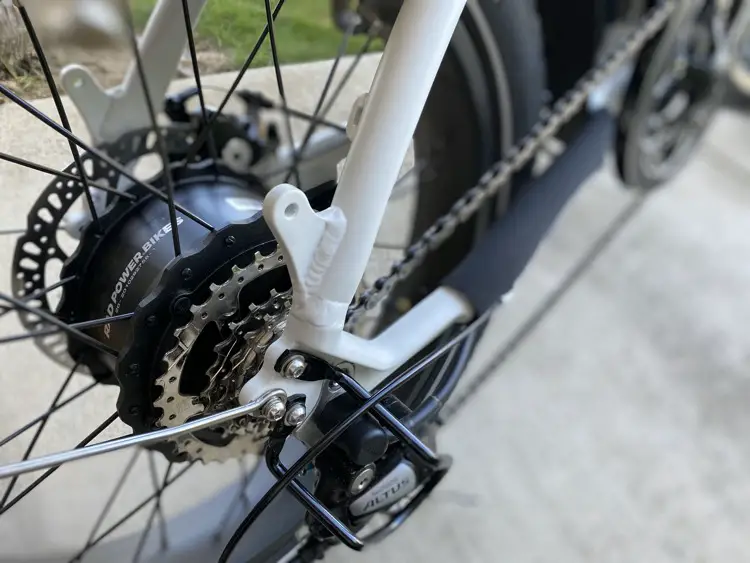
How does a mid-drive motor work?
A mid-drive motor adds another step to the process of turning the wheels. It sits in the middle of the electric bike with the shaft connected to the bike’s chain. When the motor rotates, this moves the chain, which then turns the wheel and propels the bike forward.
Because this motor is attached to the bike’s chain, it works well with the natural gear system of the electric bike, making it more energy efficient, whereas hub-drive motors tend to be single-speed motors. This however can be more expensive and can put more strain on the chain.
What is motor power?
The power of an e-bike motor is measured in watts. This is the maximum power output of the motor, but it may operate with a lower output, depending on the assistance level selected.
E-bikes can have a range of motor sizes, usually ranging from 250 watts to 1,000 watts. Unfortunately, a motor that has more power will be bigger and heavier, so you might need to compromise with a smaller motor to keep the weight down.
These numbers represent how much energy the motor can draw from the battery to turn electrical energy into mechanical energy. As a comparison, a professional cyclist can produce about 400 watts over the space of an hour. This means that most motors will feel as though a professional cyclist is pushing you along.
How Does Pedal Assist Work With The Motor?
Pedal assist is more commonly used with mid-drive motors but can be applied to both using sensors. The sensors will detect how much effort you are putting into pedaling and will adjust the power of the motor as a result.
There are two types of sensors in a pedal assist system. These include a cadence sensor and a torque sensor. A cadence sensor will measure how fast you are pedaling and a torque sensor measures how hard you are pedaling. The motor assistance will be the most accurate if the bike uses both sensors.
On its own, a cadence sensor will detect slower pedaling when you are working hard to take off, but also when you are cruising along at higher speeds. In both instances, you may be pedaling at the same rate, but require different levels of assistance.
A torque sensor is a bit more accurate at measuring how much power assistance you need, but it won’t be correct 100% of the time. This is why, if you had to choose, a torque sensor is the better choice. But a pedal assist system works best when both are used.
How Does an E-Bike Battery Work?
The battery of an electric bike is where the energy comes from. There are a few confusing terms that you might come across when looking at batteries, so here are the most important terms to know.
| Common Terms | |
| Volts (V) | How fast the electricity will flow. |
| Power / Watts (w) | The rate at which work is done, measured in watts. |
| Amps (A) | Amount of electricity (electrons) flowing past a certain point every second. |
| Watt Hours (Wh) Wh = Ah x V | Measure of power delivered over one hour. |
| Amp Hours (Ah) | Measure of electric charge delivered over one hour. |
| Range | How far your e-bike can travel on one fully charged battery. |
A battery will store energy that can be used to supply the motor when required. The motor will turn electrical energy into mechanical energy, moving the bike forward.
When buying a battery, you’ll probably be given the voltage and amp-hours of the battery. The voltage, as mentioned above, tells us how fast electricity can travel, whereas the amp-hours indicate how much electricity can be delivered by that battery over one hour.
Discover the 15 essential battery charging tips!
Voltage and amp-hours
Increasing the voltage makes an electric bike faster while increasing amp-hours increases the battery range.
These two factors can be multiplied to calculate the watt-hours of the battery, meaning how much power is delivered to the motor over an hour. This ranges from 300-1,000Wh in a typical e-bike.
Watt-hours are an easier measure of how much you’ll get out of your battery because there are many different voltage and amp-hour combinations in batteries. Having watt-hours gives us one number to compare.
A fully charged battery will allow you to ride a number of miles before it runs out. This is called the battery’s range. This is affected by many variables, which I will discuss further down, but on average, an electric bike will use 10-20Wh per mile.
This means for a smaller battery (300Wh) and using 20Wh per mile, you will be able to travel 15 miles on the one battery. If you conserve the battery, using around 10Wh per mile and have a larger 750Wh battery, you will be able to travel 75 miles.
Watt-hours
Increasing watt-hours also increases the battery range.
This, however, is assuming you are using a pedal assist motor. If you’re using a throttle, your battery range is going to be much smaller (if you’re using only the throttle). This is because, when a pedal assist motor is involved, you will be contributing to the power. Therefore the power required for an electric bike to move is divided between you and the battery.
With the throttle, you’ll need to compare the power of the motor with the watt-hours of the battery to give you the number of hours the throttle will last. If a battery has 1,000Wh, a 200w motor should last 5 hours, but a 750w motor will last around 1 hour and 15 minutes.
These are very simplified examples, but they should give you an idea of how the battery works with the motor to power your electric bike.
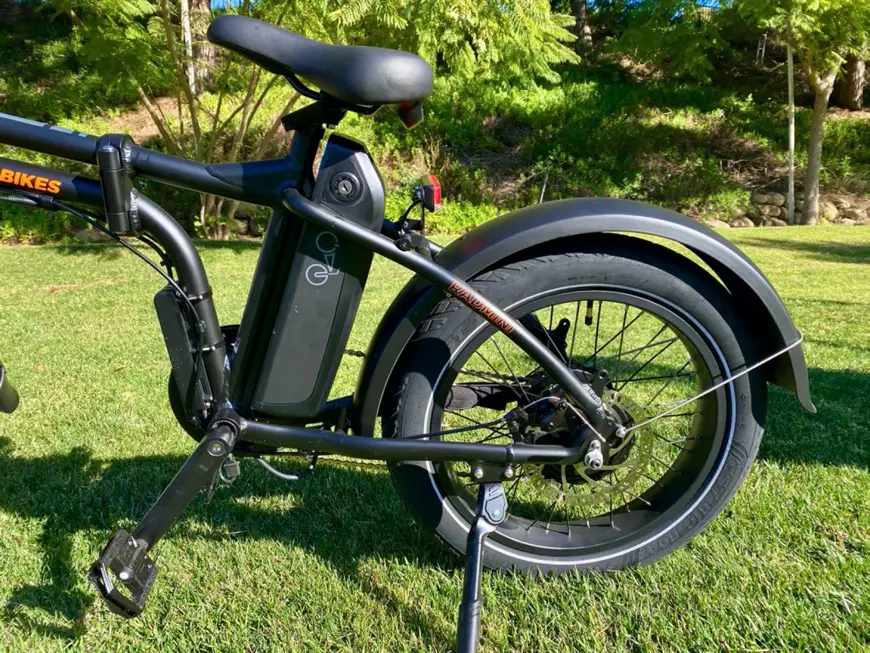
What batteries does an e-bike use?
Most e-bikes use lithium-ion batteries. Lithium-ion batteries are the same that you would find in your phone or laptop. The benefit of these batteries, and the reason they are so widely used, is that they last a long time.
This is because they are very energy-dense and can therefore hold more charge than other batteries of the same weight. Considering weight is a big disadvantage in an electric bike and actually works against the battery longevity, this is currently the best option for e-bikes.
Lithium-ion batteries work by the movement of positively charged lithium ions through the battery, which discharges negatively charged electrons through an external circuit. These electrons are what provide your e-bike with electrical energy.
Lithium-ion batteries are also rechargeable. This is done by re-introducing electrons into the circuit, resetting the lithium ions. Over the recharging cycle, they will all move back to the other side of the battery.
Unfortunately, there are no batteries that will last forever, as you may have experienced when your car’s battery died or you had to throw away the old rechargeable AAs from your camera. E-bike batteries are the same.
Depending on usage, lithium-ion batteries can only be recharged a certain number of times. On average, they will need to be replaced every three years. But for those who don’t use their e-bike every day, they might get up to 10 years on their battery. It all depends on how often it is recharged.
Some people may be wary of lithium-ion batteries because of their perceived safety concerns. Some lithium-ion batteries have been known to explode if overcharged or if they get too hot. This is why they aren’t permitted on planes. However, modern batteries will be equipped with a circuit breaker to prevent overcharging, making them much safer.
How do you charge an e-bike battery?
Charging an electric bike battery is very simple. It will come with a charging cable that you can plug into any regular power socket. Recharging a fully drained battery can take anywhere from 3-6 hours.
This is why most people will charge the battery overnight, or if riding their bike to work, they can charge it at their desk during the day.
However, not every electric bike is the same. Some have the batteries mounted externally, some will be semi-integrated into the frame, and some will be entirely encased within the frame.
Those that are within the frame are inaccessible, which means that you can’t remove the battery to charge it. You’ll need to take the entire bike to the power source.
The semi-integrated and external batteries can be removed, meaning you can take just the battery with you into the house or office to recharge. These batteries are usually locked into place with a key to preventing theft.
What affects battery use?
There are many variables that affect the range of your e-bike battery. Some you can’t control, but some you can.
- Size of the battery: A battery with more watt-hours will increase your range.
- Size of the motor: More powerful motors will use more energy from the battery.
- Weight of the bike and rider: Adding weight to the bike, whether from the bike itself or the rider, will increase resistance when riding, which will use more energy from the battery.
- Inclines and declines: Going uphill will demand more power from the battery, whereas going downhill will conserve energy. So if you live in a hilly area, the battery will usually not last as long.
- The type of terrain: Rougher terrain, such as grass or gravel, will increase resistance on the bike, requiring more power.
- The wheels: Heavier and wider tires provide more resistance when riding, draining the battery.
- Type of assistance (throttle vs pedal assist): It’s well-known that pedal assist motors are more energy efficient because they constantly adjust the amount of power used. On easier rides, they will drain less power from the battery.
- Level of assistance: On a pedal assist bike, you can choose to lower the amount of assistance the motor provides as you are pedaling. This generally ranges from less than 100%, known as ‘eco mode’, to around 300%, which is often called ‘turbo mode’. Even with a throttle, you can choose to twist by a smaller increment to use less power. The less assistance you use, the longer your battery will last.
I hope this article has answered any questions you’ve had about how an e-bike works and prepare you for purchasing and riding your very own. Understanding how an e-bike works will help you have more fun riding and, hopefully, encourage you to take good care of it.
Now find out how to use an electric bike!

